The Purpose of Mold Texture
Mold texture process is to improve the surface finishing of a plastic part
Allow the product to have a diversified or brand new design
The Definition of Mold Texture
Texturing refers to the application of chemiosmosis to create a variety of patterns on the surface of a metal product, such as stripes, images, wood / leather grains, and satin, as well as the sandblasting procedure, which directly sprays glass sand onto the surface of a metal product.
Varieties of Textures
- Sand Pattern
Characteristics: Quick process, cheap price and can produce fine and plane patterns.
- Satin Pattern
Characteristics: Quick process and can be used for a flat surface. Twice as durable as the sandblasting process, and able to cover the weld marks and sinkng marks on a rough surface.
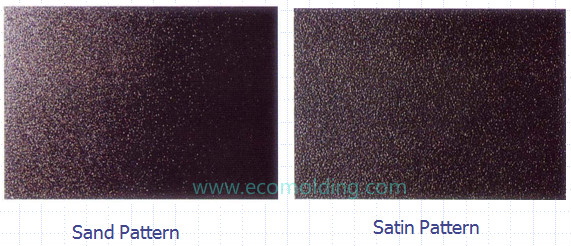
- leather-pattern
Characteristics: Durable. Product surface is abrasion resistant though cannot be fixed completely if damage. Able to remove burnt and rust marks caused by chemical gases through surface treatment.
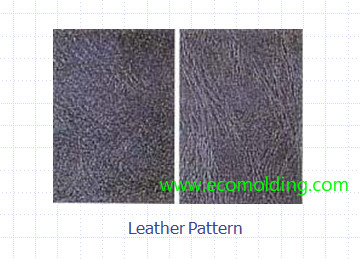
The steps of Texturing
1.Cleaning
Clean the mold cavity surface, to remove oil/grease.
2.Sealing
Apply adhesive paper or corrosion resistant coating to the cavity surface that does not need to be textured, so as to prevent corrosion. This is the most time consuming step, during which the 3 commonly used sealing materials include: Thick adhesive paper, to cover the majority part of the cavity surface; thin adhesive paper, to seal the details; and corrosion resistant coating, to cover the area that adhesive paper fails to cover, e.g. complicated curvy surfaces.
3.Drying
Dry the anti-corrosion coating.
4.Surface treatment
Carefully wipe the cavity surface to be textured using absorbent cotton, to make it free from any dirt, thus ensuring the texturing effect
5.Texture(corrosion)
Apply a coating to the cavity surface to be textured and then soak it in the corrosive fluid. During this process, attention should be paid to the texturing status. Repeated soaking is required to get the desired textures.
6.Sandblasting
Sandblasting have 2 purposes: A). To remove the residue liquid on the cavity surface with pressure washer; B). To tune the gloss of the texture; different levels of gloss can be achieved by using different sands and different pressure levels.
7.Post treatment
Clean the cavity surface and spray rust protection agent before delivering the mold components back to the mold shop.
Mold Texturing Depth
When designing a mold, if the depth of texture is deeper,then we need bigger draft angle for mold release,or it will cause scratch on product surface.Now we have some suggestion about draft angle for Mold tech texture.
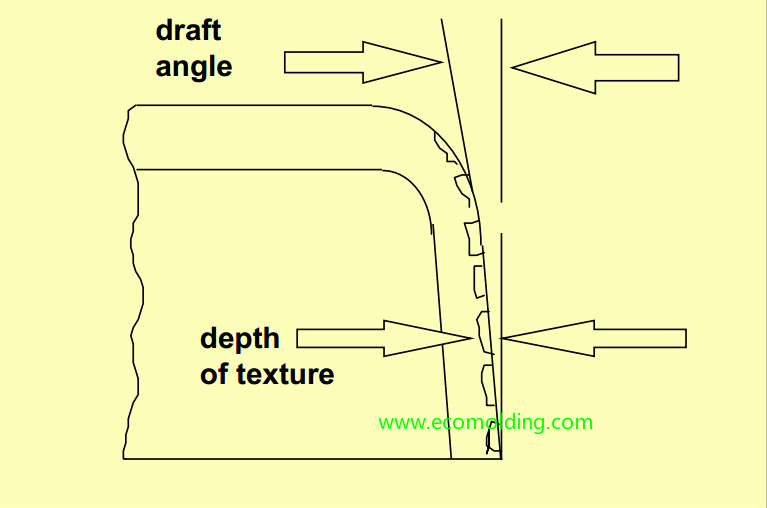
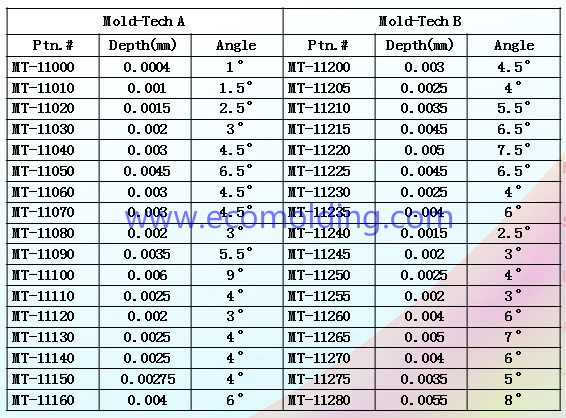
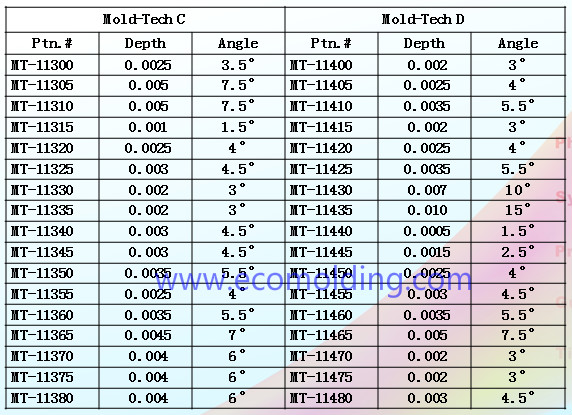
With regard to mold texturing, there are usually two cases:
1. Texturing on electrodes. When texturing, use electrodes to EDM the finish the cavity side. During EDM processing, the pattern textured on a mold possesses the natural radius of the electrodes, of which the texture will usually be deeper. Generally speaking, the main purpose of texturing on the electrodes is to make the textured surface glossy.
2. Texturing onto the core. Texturing directly on the core does not involve overlap processing during the process. As a result, what’s textured will be just the pattern on the product. And, the texture we get will be of higher quality. It is mainly intended for finer textures with high quality.
For the life cycle of a textured mold, the main determinants are:
1.The properties of steel materials – great resistance to acid is required;
2.The acid ratio of the resin material – the service life of the texture is longer when the acid ratio is higher, and vice versa;
3.The pressure of plastic injection molding. The injection pressure is another factor that determines the service life of a textured mold
